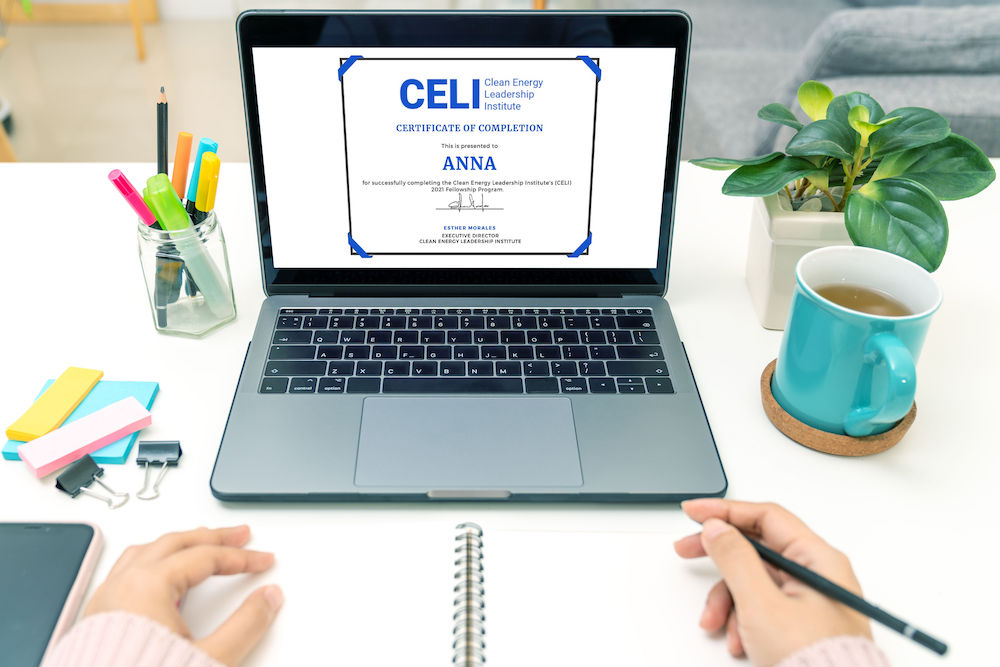ERTHE’s Anna Allenstein Shares CELI Capstone to Help Utilities Decrease Carbon Emissions

Anna Allenstein, Senior Project Manager at Erthe Energy Solutions, has a passion for making an impact on the future of the energy industry. She was recently honored to be offered a Clean Energy Leadership Institute (CELI) Fellowship, a program to develop professionals in their fields to become clean energy leaders who can work toward an equitable, decarbonized, and resilient energy ecosystem.
At ERTHE, Anna builds and manages solutions for our utility clients. She was excited to continue her professional development as a 2021 CELI Fellow.
At CELI, Anna became a part of a community of change-makers who came together to learn more about energy systems, energy justice principles, and leadership training. “As a CELI Fellow I enjoyed accessing the expertise needed to zoom out and think critically about the industry, where we are headed, and how ERTHE can help make a greater impact,” says Anna.
One aspect of her experience was developing a capstone project, which we are pleased to share with you today. For her capstone, Anna wrote this article, citing the challenges with reaching utilities consumers. Anna presents a vision for how utility companies can coordinate to help make it easier for customers to enroll in energy efficiency programs. Enjoy her capstone below!


Maximizing What You’ve Got: How Utilities Can Deepen Decarbonization with Existing Programs
By: Anna Allenstein | September 25, 2021
As we look to decrease carbon emissions and meet climate goals, harnessing existing utility programs to drive improved results will be critical. Not only will coordination of these existing programs deepen decarbonization, but it will also increase customer satisfaction. Consumers expect the best experience from every service and product they purchase, and utility customers are no different. While they want uninterrupted power, they are also looking for their utility to be the expert and legitimize the many offers and solutions on the market today. Many customers rely on their utility already—so utilities are in the perfect position to help their customers with all their energy needs. Many of these energy needs are successfully addressed with existing utility programs that help customers save energy: energy efficiency, demand response, and distributed generation programs to name a few.
Traditionally, these programs operate separately, with unique calls to action and different teams implementing them. This is for good reason. They have different goals and technical requirements. As someone who has spent a majority of my professional career marketing energy efficiency programs, I can’t help but envision all these solutions being packaged together to provide utility customers a comprehensive energy-saving experience and deeper savings. How we get there needs to be intentional, and what looks like to the customer should be seamless.
Packaging energy efficiency, demand response, and distributed generation programs together into one comprehensive experience for customers would require breaking down silos, but not necessarily merging these programs into one, singly managed program. These programs can be coordinated with regularly occurring communications between program staff, as well as intentional marketing and market engagement.
Intentional marketing: Rather than disjointed, multiple calls to action, a clear call to action and avoiding the “too good to be true” perception can help inform eligible customers, so they know how and why to participate in the programs and feel confident taking the next step.
- Clear Call to Action: Each customer will have different needs so their experience in these programs will be unique, for example—the order of the solutions they implement and whether a solution is a good fit at all. Therefore, the call to action must account for this. It must be general enough to cover all the available solutions but specific enough to connect with the audience. One option is to lead with the first step of the ideal customer journey. Once the customer is participating in one program, introduce the other programs available to the customer as a suite of services in their roadmap to energy savings.
- Avoiding the “Too Good to be True” Perception: One of the common perceptions in marketing energy efficiency programs among eligible customers is that the program is too good to be true—with the main question being “Why does my utility want to help me save?” As utilities offer more, better solutions, this perception will only grow. The best way to combat this perception is to engage with and educate key community leaders who can legitimize the programs for weary customers. This includes utility government affairs and corporate communications, business leaders, real estate managers, non-profit directors, government officials, neighborhood organization leaders, and others. Informing all these individuals is key to ensuring that when they are asked about the programs, they can provide consistent and clear answers.
Intentional market engagement: Once engaged with the programs, the relationship developed between the customer and their main point of contact matters. A cross-trained expert is needed to guide the customer through all available services and products and deliver a comprehensive roadmap. This expert could be a utility employee, part of a consulting firm that is hired by the utility, or an independent contractor who has experience working in one or more programs. The important part is that this point-person is not just representing one program—they are trained to represent all solutions. One of the most promising market trends is that energy efficiency trade allies have been expanding their services to offer their customers a more comprehensive suite of solutions. This includes electrical contractors expanding their business beyond installing lighting retrofits within energy efficiency programs to include distributed generation. These trade allies are knowledgeable and can speak to customers about all their options. Further training can ensure these trade allies can also promote demand response programs, or any other offering the utility provides.
The work to coordinate these programs is real, but the opportunity for deeper energy savings is just as real. Once a customer has entered one program, presenting them with other energy-saving options helps them to choose what is right for them and develop a long-term plan to saving. This ensures a relationship is developed so savings can be captured year over year as new products and solutions come to the market. Whether you’re a utility marketer who helps bring these programs to your customers or in a leadership position where embracing this vision can make it a reality, explore how bringing a coordinated solution to your customers can help you not only achieve, but surpass your goals. If you are already doing this in some form, bravo—share your best practices and join the conversation. You are our beacon and I hope more will gladly follow.

We are so proud to have Anna as a part of the ERTHE team! As you can see, she is passionate about thinking creatively and finding solutions that can take the industry to the next level of clean energy. Anna fits right in at ERTHE, where we are passionate about the industry and committed to being leaders and helping our clients implement strategies and programs that will make them leaders in the energy industry.
Interested in refining your energy efficiency program or portfolio?
Are you in the utility industry and looking for ways to incorporate some of these ideas into your programs or portfolio? If so, please contact us today. We’re always excited to help the industry evolve.
